From the COVID-19 pandemic to conflicts in Ukraine and the Middle East, the launch of the Unitary Patent, and emerging technologies such as Generative AI (GenAI), IP professionals face new and fast-evolving hurdles to effective IP management. Subject Matter Expert, Fanny Coignard, discusses what these emerging trends and challenges mean for IP owners and managers and how our innovative software, Orbit Intelligence, can provide support.
In our recent webinar on 'Decoding IP Trends in Europe', we explored the evolving European IP landscape over the last three years to chart the impact of significant recent global events and identify the IP trends, opportunities and obstacles that lie ahead for our industry in the years to come.
Three European IP Trends That Are Here to Stay
- Trend 1: Geopolitical Unrest
Among the many topics discussed in our recent webinar, we looked at how the 'old' challenges of managing IP portfolios in times of increasing globalization and fast-evolving geoeconomics have been replaced by a new focus on emerging geopolitical risks.
Major global events—such as the COVID-19 pandemic, the ongoing conflict between Russia and Ukraine, and unrest in the Middle East—have shaken how countries interact and disrupted the stability of the world economy. The U.S. and European countries are heading toward economic troubles, China is growing at a much slower pace, and tensions are rising between countries worldwide.
- Trend 2: The Unitary Patent
What makes things even more challenging for businesses is that these difficulties coincided with a game-changing development in European patent law: the launch of the Unified Patent Court (UPC) system on 1 June 2023. By removing the need to validate European patents (without unitary effect) in each country, the new European patent with unitary effect (or "unitary patent") offers a quicker, cheaper, more harmonized method for filing patents in Europe.
The classical European patent (EP) requires patentees to individually validate granted EPs into their European Patent Convention (EPC) contracting states of choice, creating a bundle of individual national patent rights. Now, innovators can request a single unitary patent with uniform territorial scope across the 17 EU member states that have (currently) ratified the agreement.
Given that European countries, such as the U.K. and Switzerland are not party to the UPC agreement, applicants may still need to utilize the old EP system or a combination of the two to ensure coverage in all their markets, however.
- Trend 3: Technological Transformation
Increasing energy prices and climate change are adding to rising global tensions. Yet, the conflict in Ukraine and the growing cost of energy are also driving greater adoption of cleaner and more renewable forms of energy, creating investment opportunities and driving innovation in the process.
Similarly, the aftermath of the COVID-19 pandemic has prompted many nations to reassess how they work together to mitigate future global risks, including how they develop and license vaccines. For example, COVID-19 accelerated a significant scientific breakthrough in vaccine development: the mRNA technology revolution. This transformative technology played a crucial role in responding to the pandemic and promises to help address future healthcare challenges.
Other technological trends are related more specifically to information and operational technology, from the rise of artificial intelligence (AI), including GenAI tools such as ChatGPT, to the escalating frequency and severity of cybersecurity attacks.
Post-lockdown, it was inevitable that individuals, financial systems, and national infrastructure, including healthcare, would become increasingly reliant on technology. On the one hand, this has led to the rapid evolution of AI large language models (LLMs), with online tools emerging that are reshaping how we research, discuss, create, share, and manage content. On the other hand, it has also put our personal, corporate, and national information, systems, and infrastructure at risk of cyber-attack, whether by individuals or rogue states.
What Can Patent Analysis Tell Us About These Global IP Trends?
By searching and analyzing European patent data in Orbit Intelligence, we can quickly discern many trending technologies and rapidly access valuable, competitive insights, including industry fields, description and claims summaries (using our fully secure and confidential ChatGPT interface), technical features, and key concepts.
The European Patent Landscape
By searching for all European patents filed in the last five years in Orbit Intelligence (using code "EPRC", pictured here), we identified more than 400,000 European patent families when we undertook this analysis at the end of January 2024. Using the graphical view/summary module of Orbit Intelligence (see Figure 1, below), we could quickly identify some interesting trends.
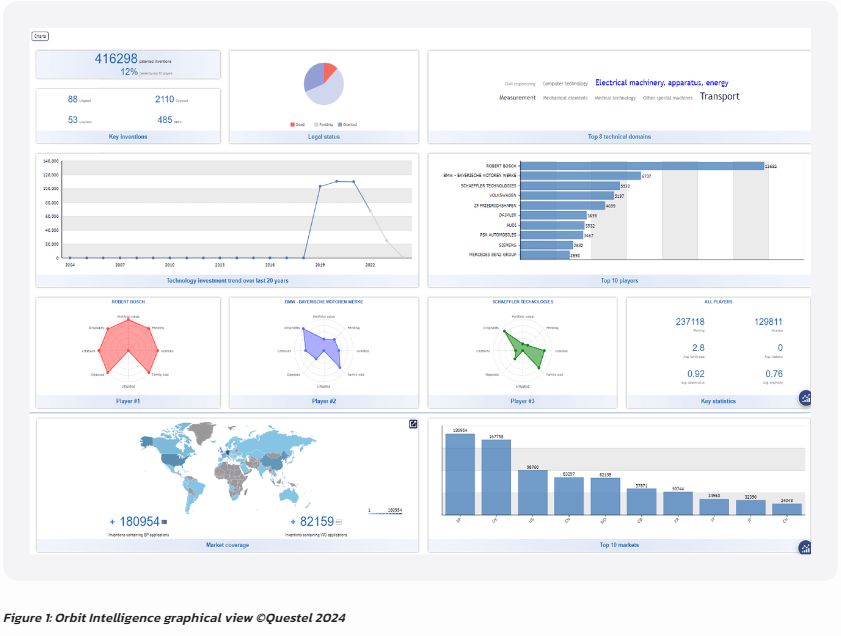
Firstly, it is evident from the data that there has been a consistent decrease in priority filings in Europe (see Figure 2, below) over the last three years. (Given the 18-month delay between filing and publication, we extrapolated the numbers for 2022.)
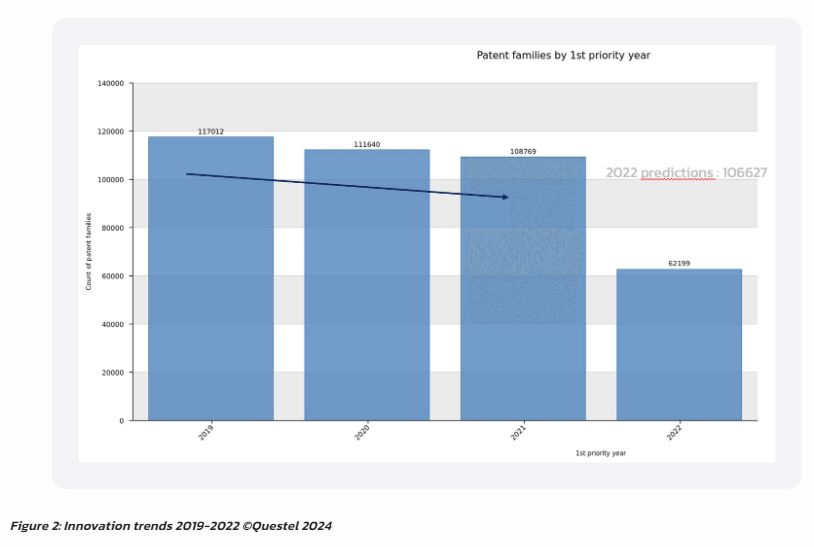
Interestingly, this situation mirrors that of the U.S., whereas our research shows that priority filings in Asia have increased in recent years. It begs the question of whether Europe (and, indeed, the U.S.) will be prepared to tackle the challenges that may arise in the future....
Of course, Europe includes many different countries, so we filtered our results by nation (see Figure 3, below). This reveals that Germany is significantly ahead, with more than half the priority filings, followed—at some distance—by Great Britain and France.
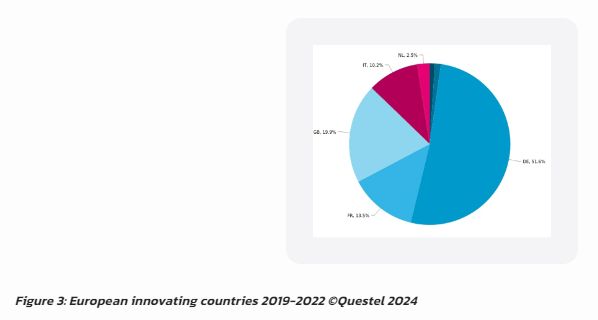
However, further investigation (see Figure 4, below) reveals that, for example, GB priority filings have remained relatively consistent, whereas Germany's have dropped drastically. This suggests that the decline in priority filings across Europe that we observed above can be linked directly to the decline in German (DE) filings.
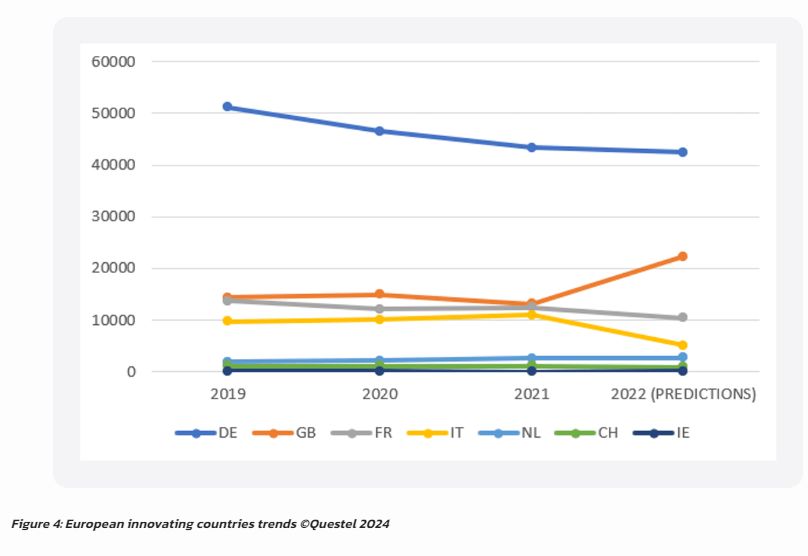
Who Are the Top Filers?
Next, we drilled down to assess the top players by patent family by first priority year (see Figure 5, below). Perhaps, unsurprisingly, the top assignees are German companies (Robert Bosch, Volkswagen, BMW, Zeppelin, Mercedes Benz, Siemens...), with the first non-German applicants Valeo and Safran (ranked 9 and 10), both French companies.
Safran (at number 10) is not only the first non-German but also the first non-automotive company, with the top nine assignees either automotive companies or manufacturers of automotive equipment.
Given our interest in analyzing IP trends over the last few years, we also explored the priority filings of these top assignees between 2019 and 2022 (see Figure 6, below). As can be seen, there has been a major drop in filing by the two top companies, although Volkswagen may potentially recover in 2022. We can also see a common trend in 2020, with a sharp drop in filing by most companies, especially Zeppelin and PSE Automobiles. However, by 2021, their priority filings had returned to the levels observed in 2019. The COVID-19 lockdowns of 2020 are the most likely reason for this temporary decrease.
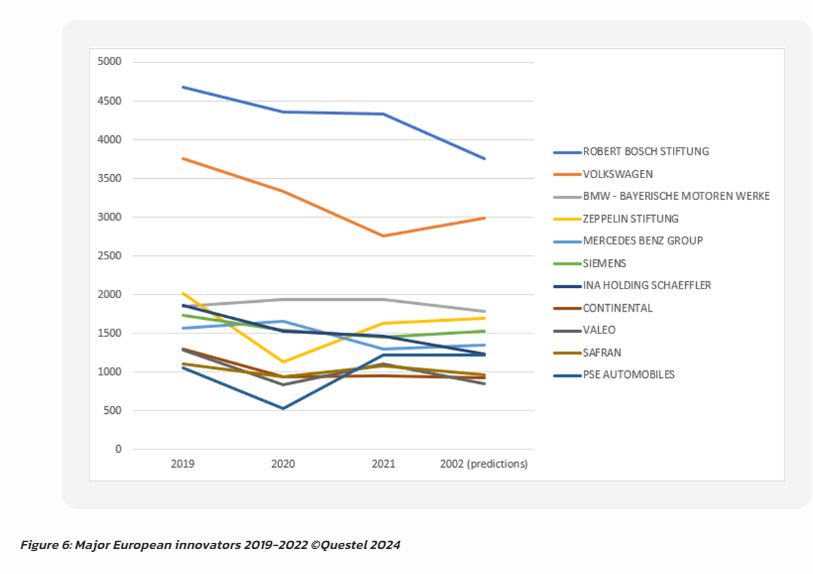
What Can We Learn About Unitary Patent Adoption?
By focusing on the unitary patent filing data, we can see that the top filer for 'EPC 0' (the unitary code) is Siemens and by a significant margin:
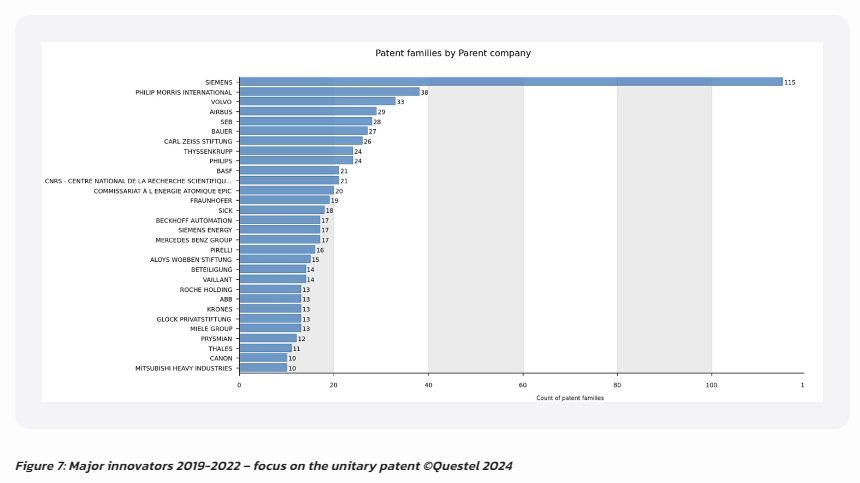
The German multinational technology conglomerate has three times more EPC O patents than Philip Morris International at number 2. Interestingly, Philip Morris International and Thyssenkrupp are among the top 10 unitary patent filers despite not being among the top players in Europe (by filing numbers—see Figure 7, above), suggesting that while the top German automotive companies may not be pursuing the unitary patent route, other companies are choosing to do so.
By comparing the data, we can also see that most companies are adopting a 'hybrid' approach to the unitary patent, incorporating both classical European patents and European patents with unitary effect into their portfolio. It will be interesting to see if this trend persists in the coming years.
IP Trends in Technology
We have examined global country-specific and assignee-related trends, but what about the technological landscape? By looking at the Cooperative Patent Classification (CPC) data, we can see that the most prominent industries by technology field also match our findings of a decreasing filing trend:
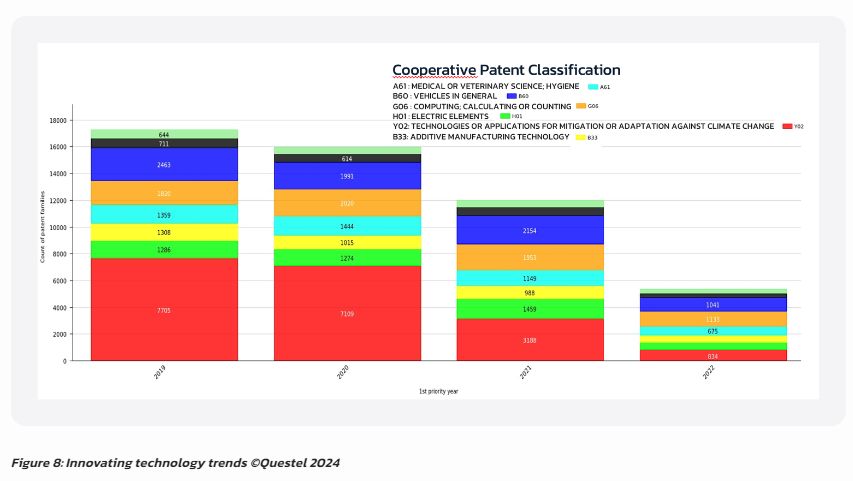
The largest (red) segment is for technologies or applications for mitigation or adaptation against climate change (Y02), the dark blue portion corresponds to patents classified as vehicles (B60), the light blue segment to medical or veterinary devices (A61), and the orange segment to IT models and machine learning (G06 – computing, calculating, or counting). However, if we examine these numbers from a different perspective, it becomes evident that the top blue line (A61) is the leading field, with priority filings increasing over the last three years (see Figure 9, below). This trend is not so surprising given that 2020 was dominated by the COVID-19 pandemic, leading to a surge in medical research.
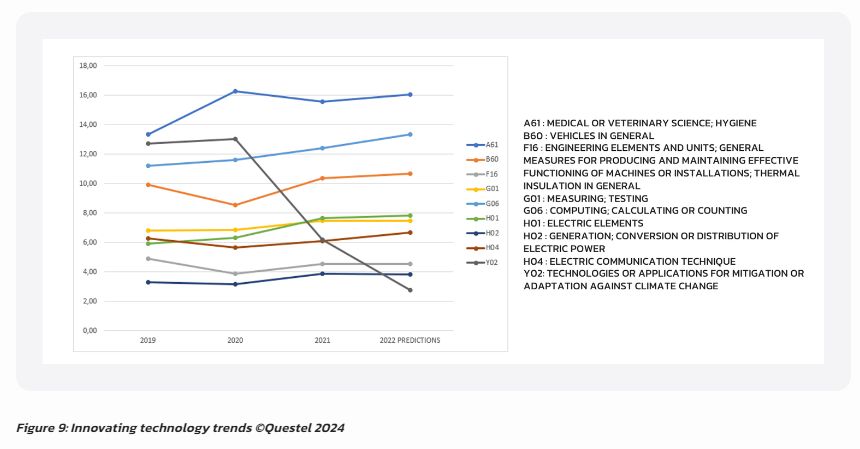
Meanwhile, the second gray line, corresponding to Y02 (applications for mitigation or adaptation against climate change) experienced an incredible drop in this period and looks to be continuing the same downward momentum. This is quite unexpected and could lead one to speculate if the focus on the pandemic or recent inflation in Europe has prompted countries to refocus on non-renewable energy in preference to climate change adaptation.
Finally, the third line in the light blue color (G06), relating to IT models and machine learning technologies, shows a steady increase over the years. Let's explore these three domains (A61, Y02, and G06) in more depth to see what else we can uncover.
Medical, Environmental, and IT Innovations in Europe
Starting with the top concept (A61), which represents the medical science field (see Figure 10, below), we can observe a notable increase in concepts related to infection and viruses in 2020, likely due to the COVID-19 pandemic. While the numbers return to a more normal level, they continue to show an increasing trend in 2021.
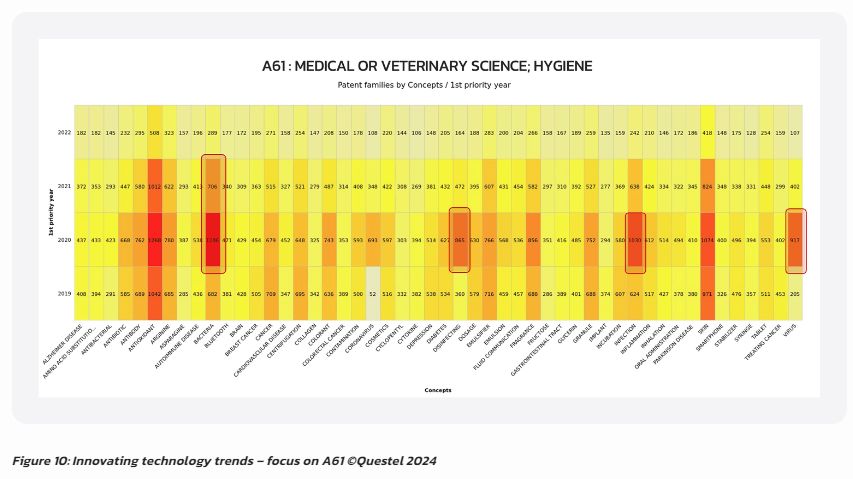
When examining Y02, covering technologies for adapting to climate change (see Figure 11, below), we can observe two different trends. Some fields, such as electricity battery and fuel cells have remained relatively steady between 2019 and 2020, while others have experienced a steady decline. Meanwhile, in 2021, we can see new domains emerging, such as wind turbines, indicating diversification outside the electricity sector.
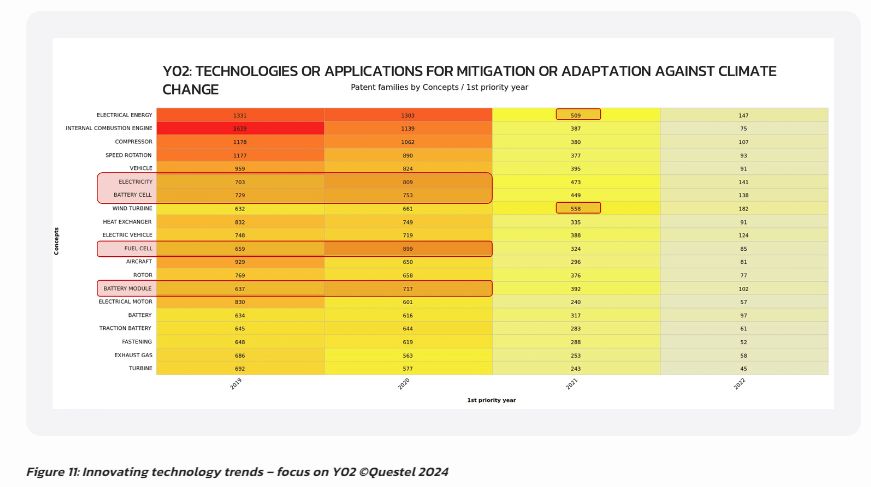
Finally, let's look at G06, which relates to computer systems employing specific methods of calculation, such as the knowledge-based model in the G06N 5/00 subclass and machine learning in the G06N 20/00 subclass. Here, we can observe that the overall G06N class has been experiencing a slight increase over the last few years, with the predicted numbers for 2022 aligning with this trend.
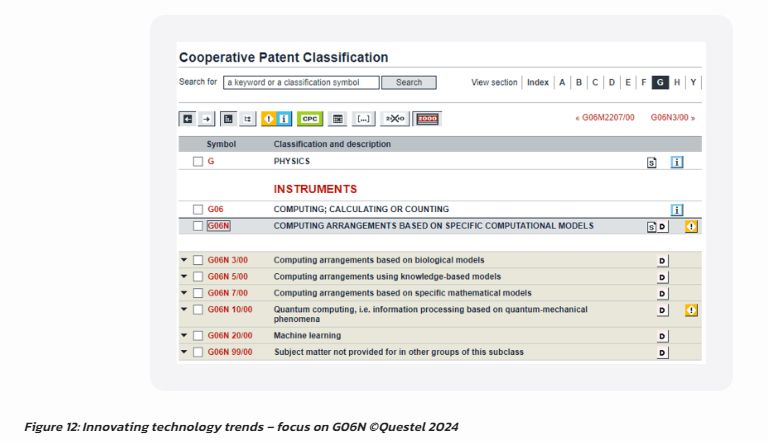
As most filing relates to biological models (G06N 3/00), let's examine next who the leading players are in this trending technology. Not surprisingly, we observe that the top actors in this technology area—Robert Bosch, Siemens, Volkswagen. etc.—are the same as those we saw at the beginning of this analysis. Interestingly, the French Commissariat à l'Énergie Atomique (EPIC) has risen in prominence. However, there are no entirely new actors among the top filers in this domain, raising the question whether these established companies will continue to drive innovation in Europe.
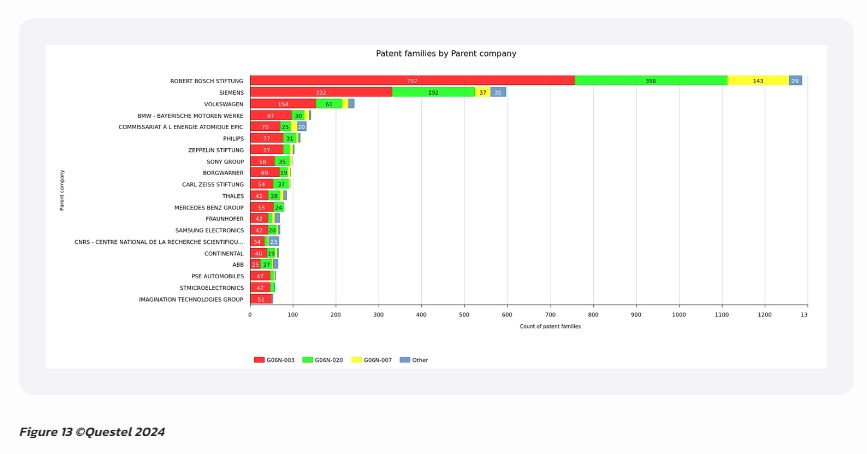
European IP Trends from 400,000+ Patent Families
In conclusion, our analysis of these more than 400,000 patent families has revealed a gradual decrease in priority filings, with Germany still leading the field despite a decline in recent years. We will continue to monitor the data considering our three key IP trends to establish whether:
- The unitary patent will help to drive innovation by making European patents simpler and less expensive to obtain;
- COVID-19 will continue to boost research and development in the field of medical science;
- Emphasis on technologies aimed at climate change adaptation will continue to decrease, in favor of renewable energies or diversification in the automotive sector towards electrical vehicles; and
- IT models and machine learning technologies will continue to rise in prominence despite the lack of new entrants to this promising field.
Given the gradual decline in filings in Europe overall, questions do arise about the future of innovation leadership in Europe, highlighting the need for collaboration and adaptation strategies. By monitoring these trends closely, innovators can adapt their strategies to foster collaboration to address global challenges and ensure Europe remains at the forefront of technological advancement.
As we hope this analysis of European patent filing illustrates, Orbit Intelligence can provide vital insights into global innovation and IP trends. For more information on the topics covered, please watch our recent webinar on 'Decoding IP Trends in Europe' or contact our Subject Matter Experts for dedicated support.
The content of this article is intended to provide a general guide to the subject matter. Specialist advice should be sought about your specific circumstances.
